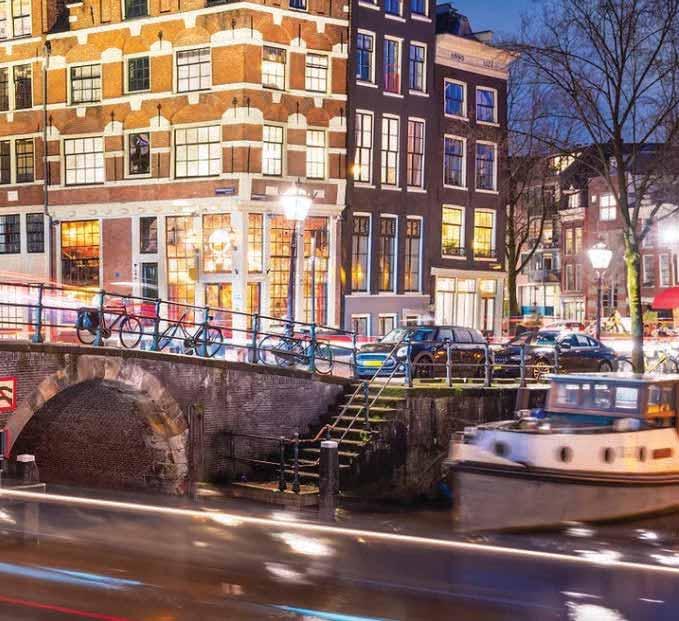
4 minute read
Light for wellbeing
SLL CONFERENCE
Shaping light for health and wellbeing in cities
Advertisement
The aim of the forthcoming SLL online conference – 16 and 17 December 2021 – is to investigate the multi-faceted consequences light has on life in cities. Contributions from participants will support the collection of evidence on indoor and outdoor lighting impacts on health and wellbeing. They will be analysed considering their various domains (medicine, social sciences, urban and lighting design, urban planning, ethics, etc) and included in the development of tools and policy guidance to support the decision-making processes, ensuring the integration of health and wellbeing domains in urban lighting plans.
See https://www.enlightenme-project-conference.com/
A major consequence of urbanisation is an exponential increase of human exposure to electric light at night. Public outdoor illumination and the artificial sky glow created by highlyurbanised areas are the main sources of exposure. This is complemented by increasing exposure to light at the individual level through domestic lighting and light-emitting screens, or too little exposure during the day due to shift work or unregulated lifestyles.
Buyers, manufacturers, regulators, local authorities and end-users all have a vested interest in high-quality, long-lasting, energy-efficient LED products. The qualifications here are very important. It is the performance of the LED that determines the financial, energy and carbon savings. However, it is important to understand what LED failure means before we begin to discuss performance.
The consequences of inappropriate and disruptive light exposure, generated by the urban environment, profoundly affects people’s health and wellbeing, altering the circadian rhythm. These effects cannot be overlooked, especially when they affect vulnerable populations like older adults who very often suffer disproportionately. Light also shapes urban spaces and social life, thus influencing peoples’ behaviour, moods and sense of security, as well as social relationships, easing or hampering socialisation and participation in civic life.
Although public awareness of light-related health and wellbeing issues is increasing, there is less understanding of how health impacts derived from urban lighting are mediated by social inequalities present in cities that may determine the kind and amount of light that citizens are exposed to. Brief details of the various sessions are as follows.
Session 1
This session will present papers and presentations focused on urban modelling and spatial statistics for lighting, health and wellbeing. Presentations will cover specific applications of multi-domain urban modelling tools, big data analyses and “Smart Cities” approaches for urban wellbeing using socio-economic and health geospatial data, examples of urban studies on geospatial data for lighting, and lighting detection from satellite data, drones and luxmeter for high resolution and prospect analysis.
Session 2
Urban lighting is shifting from a largely technical and engineering matter to being understood as involving complex connections between the technical and the social that municipalities need to understand better. Topics covered will include: • How can lighting better support social goals such as inclusion, equality, diversity and quality of life, particularly for older citizens? • How can we better understand the citizen issues and social life as a basis for better urban design, including lighting? • How can ENLIGHTENme research connect with and contribute to wider currents in social lighting and
night-time design, both in academic and professional practice? • How can innovation in lighting technology, control systems and urban design contribute to wellbeing?
Session 3
This session will comprise papers/ presentations focused on citizen participation in public space design, including a concern with research and design as social interventions.
Session 4
People are born with a certain genetic make-up. This make-up makes them more or less sensible for environmental effects and exposure. Some of the questions to be posed are: • What is currently known about the
effects of genes and environment on health, wellbeing and circadian rhythms? • Are the effects of the environment (e.g. lightning) extra strong for older people?
The session will also show the latest findings in the field of genetics with respect to circadian rhythm, along with innovative ways to study the environment by using an environment-wide approach.
Session 5
Even if there is an increased concern about the effects of exposure to artificial lighting on health and wellbeing, it is not considered enough in the current urban policies. Instead, urban lighting policies suffer from a sectorial approach, mainly oriented to reducing energy consumption and CO2 emissions, as well as improving urban safety or strengthening city branding.
Human health and wellbeing implications due to urban lighting is a topic that remains rather unexplored in current urban lighting plans.
The aim of this session is to emphasise innovative urban lighting policies and plans, good practices and pilot actions embracing diversified goals among which wellbeing and health promotion is compromised.
Session 6
Urban lighting interventions pose ethical challenges for the impact on communities and the environment. This is particularly true when we consider the ethical implications posed by electric lighting to human health. This session will map out and analyse some of the ethical concequences.
It will also unravel another aspect of research on health and urban lighting which is the tension between the benefits of open data and approaches that comply with high standards for data protection and GDPR compliance in the collection, handling and sharing. of health data.











